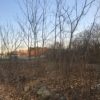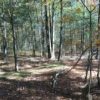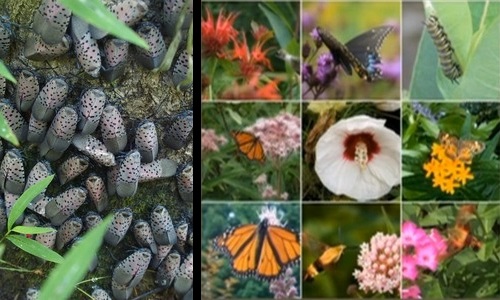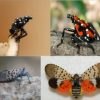Above: An Article asks voters to use CPA funds to improve conserved open space by replacing invasive plants (including one that may attract an invasive, destructive planthopper) with plants native and beneficial to our region. (images L-R cropped from Penn State News and OSPC’s presentation)
[Editor’s Note: Reminder, Annual Town Meeting is a week from Saturday at 1:00 pm on March 23rd. For more posts related to ATM, click here.]
This week, I’ve already covered two of the new Community Preservation Act projects Town Meeting voters will be asked to support. Here’s the third.
The Open Space Preservation Commission is seeking funds to replace invasive plants with native species on town-owned conservation land. Article 24 will ask for up to $20,300 in CPA funds for the intitiative. (The project is estimated at $18,300 with the additional $2K as contingency.)
Last week, OSPC’s Karen Cvitkovich presented to the Board of Selectmen and Advisory Committee. She explained that the work will mainly target two problem invasive plant species – one known to attract the spotted lanternfly and another that has been destructive to the Town’s iconic stone walls.
The intent is to remove the invasives. But, as OSPC and CPC Chair Freddie Gillespie stressed, if they don’t plant something in the place of removed plants, other invasive plants will likely move in. Therefore, they will plant native species in their place.
Cvitkovich said that the native plants will require less water and are hardy. They also have a secondary purpose of supporting native pollinators like endangered bee species.
The project is focused on two properties. One of those is 32 Cordaville Road. Some of you may realize the second address is the same as the Golf Course and new public safety complex.
 Gillespie explained that they didn’t refer to the golf course, because the work isn’t for the course. That project includes killing the Japanese Knotweed that is wrecking the stone wall along Route 85. The deep roots are dismantling the stones. And in the springtime, the plant is like a wall blocking the view of the stone and the heritage plants behind them.
Gillespie explained that they didn’t refer to the golf course, because the work isn’t for the course. That project includes killing the Japanese Knotweed that is wrecking the stone wall along Route 85. The deep roots are dismantling the stones. And in the springtime, the plant is like a wall blocking the view of the stone and the heritage plants behind them.
Still, she mentioned that the project does have a benefit for the course. Eliminating invasives is one of the steps for achieving Mass Audubon certification for the course. That is a project that voters approved the Town working towards in order to improve the marketing value of the course.
 As for the lanternfly problem, that is related to a stand of Tree of Heaven plants on the property. OSPC referred to them as bait for the insect.
As for the lanternfly problem, that is related to a stand of Tree of Heaven plants on the property. OSPC referred to them as bait for the insect.
Gillespie explained that the tree, which is from the lantern’s fly native home, attracts the insect for breeding. Once the insect has mated, it’s less picky. It will lay eggs on any trees and the hatched nymphs will eat all kinds of plants. She warned that the invasive is making its way to our state and has been devastating to plants in other regions.
The OSPC Chair said the spotted lanternfly has been called “the worst insect to hit our shores in 100 years, maybe ever.” (You can see images of the fly from the presentation below.)
By getting a head start on identifying and removing the Tree of Heaven, the commission hopes to limit the level of infestation in our area.
 The other parcel covered by the Article is the Halloran property purchased by Town Meeting last year. The OSPC presentation described it as “Relatively invasive free” but noted there is an “Oriental Bittersweet infestation at property edges and some invasive hot spots in the interior”.
The other parcel covered by the Article is the Halloran property purchased by Town Meeting last year. The OSPC presentation described it as “Relatively invasive free” but noted there is an “Oriental Bittersweet infestation at property edges and some invasive hot spots in the interior”.
Gillespie assured Selectwoman Bonnie Phaneuf that they wouldn’t need another department (like Public Works) to do any of the work. Because of nearby wetlands, there are some constraints.
OSPC intends to use a company they have worked with at Breakneck Hill Road. Gillespie explained that the contractor uses a “cocktail” mixed specifically based on the plant and its location. Gillespie acknowledged that while OSPC doesn’t like using chemicals it in some situations it is the least invasive method.
DPW Superintendent Karen Galligan wondered about the impact of removed plants on the Transfer Station budget. She asked if disposal of materials was in the project budget.
Galligan said that a project last year to remove purple loosestrife resulted in a lot more bags of material than they anticipated. Gillespie believed it was but said that if they need to work out a budget for that with the DPW they will.
Selectmen urged her to do that. Selectman Dan Kolenda reasoned that if something in an Article impacts another budget, it would be good to work out in advance.
Gillespie told selectmen that removal of the Tree of Heaven can be done quickly and Oriental Bittersweet in about a year. Effectively removing the Japanese Knotwood will take three years. But even for that plant, results should be seen immediately. The weeds will be cut back but eliminating the roots takes longer.
Kolenda pushed for the Commission to come back with before and after photos. He urged the OSPC to demonstrate their CPA projects’ success for the public.
Selectmen unanimously supported the article. For the full text of Article 24, click here.





I have a problem spending that amount of money to remove unwanted vegetation , I would support planting street trees where they are needed. Or replant some of the ex Apple orchard on Breakneck Hill Road with 50 or so apple trees, It was a crying shame that all of those apple trees were cut down.useing CPA funding , so lets use some of that funding to plant new trees around town and worry about the unwanted vegetation down the road.
If these dangerous plants and invasive species are not stopped, there will not be a good, healthy environment in which to plant trees. These invasive species are devastating to healthy trees. Take a look at what has happened with the Asian long horned beetle in Worcester and nearby towns. The tree environment in Town is already weakened from moths devastation. The answer is to take preventative measures now and plant new trees.
Ms. Gillespie Bittersweet has invaded all areas here, and really must be eliminated all the time. The field on Parkerville right side is infested with it, traveling down Sears has a serious problem. It is growing on the utility wires overhead. Bittersweet literally takes over and chokes trees. What can we do.
Where does the brush from the dump actually go? If it’s mulched and shared with people down the road then any knotweed dumped there will likely spread wherever that materials is used next.
There is more here than you want to know about what I call the Official Vine of the Town of Southborough. Have you noticed how bittersweet has blocked the view of the Sudbury Reservoir along the SRT? And have you noticed how numerous robins are where bittersweet grows? The berries can reside in the guts of birds for many days, then be purged far and wide to start a new crop of vines.
https://www.canr.msu.edu/news/oriental_bittersweet_an_aggressive_invasive_plant
https://www.fs.fed.us/database/feis/plants/vine/celorb/all.html
I would love to see a cleanup of the ornamental bittersweet on white Bagley Road at Partridge Hill Road adjacent to the walking trail. The bittersweet has downed many trees and they have been left. I believe this is both a fire hazard and an eyesore and the bittersweet will continue to flourish if left in its own. Could the CPA add this to their efforts ,